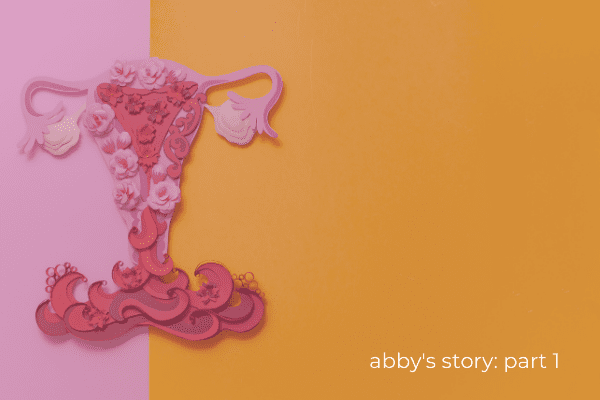This series was originally published in March 2020.

Abby has graciously shared the story of her battle with endometriosis as part of our Endometriosis Awareness editorial series. She lays it all out- the good, the bad, the ugly. We applaud her courage and vulnerability and encourage other women to share their stories.
The Beginning: Pre-Diagnosis
I got my first period at age 13. At the time, I assumed every girl had to take 4 ibuprofen, 4 times a day along with Tylenol to try to manage the pain. I assumed it was normal to have to stay home from school because I was throwing up from the pain. Everyone said, “Oh, you just have bad cramps.” Teenagers have no clue about their bodies, and I certainly didn’t have a clue what was going on.
From ages 13 to 18, I would end up in the ER numerous times from the debilitating pain. I was never given an exam, never thoroughly checked, and always dismissed. “You have cramps, go home.” Sometimes they gave me oxycodone when the pain couldn’t be controlled with ibuprofen or Tylenol, which was equally debilitating- I’d feel impaired, have to miss school, and couldn’t drive.
In addition to the pain with my menstrual cycle, I was having severe digestive issues. Everything I ate went right through me. I was constantly in the bathroom, which caused very unhealthy weight loss. I went to gastrointestinal specialists, who had me try several different diets, none of which worked. In the end, they diagnosed me with Irritable Bowel Syndrome—basically a blanket diagnosis because they didn’t know what was wrong with me.
When I was 18, I was at work and suddenly had excruciating pain like I had never had in my life. I had experienced plenty of pain, but this was off the charts. I was shaking, sweating, doubled over on the floor. My dad picked me up and took me to the ER, where I was forced to wait for 6 hours to be seen, as this was “not an emergency.” A male physician told me that I just had cramps and sent me home.
A couple of weeks later (between cycles), the pain came back, just as bad as it had a couple of weeks prior, and just as suddenly. I had a friend take me to see an OB physician, instead of going back to the ER. At the OB office, they did a vaginal ultrasound, which was excruciating and traumatizing. But they found a cyst the size of a baseball, and it had burst. This lead to a few appointments, where the medical team really listened to me and my experiences- for the first time ever.
Diagnosis, and the Beginning of My Treatment Journey
My doctor was pretty sure at this point that I had endometriosis and scheduled a laparoscopy to get a better look at what was going on. They made 3 small incisions, each the size of a fingernail, in my abdomen. What they saw inside was widespread endometriosis. They decided to not remove anything because it was wrapped around my ovaries and other organs, and they didn’t want to risk injury to my reproductive system, as I was only 18.
My medical team recommended hormone therapy. Endometriosis feeds off estrogen, so many patients go on oral birth control pills, or have an IUD placed to try to “starve” the endometriosis. Unfortunately, those options didn’t work for me. Instead, they put me on Lupron, an injection.
Lupron was in some ways a miracle treatment, in that it allowed me to regain quality of life, and helped to stave off the invasion of endometriosis in my body. But it didn’t come without drawbacks. Lupron essentially sent me into early menopause. I was attending college in Chicago, sitting in class, and having major hot flashes- sure that the whole class could see my body on fire. I now have so much respect for women who have hot flashes, because they are no joke. I was on Lupron for years. It was hard on my body. My young body wanted to have a normal menstrual cycle, but the Lupron was preventing it, which led to a lot of daily bleeding. When this became too serious and disruptive, my doctor would stop the Lupron for a while to let my body readjust. Every 3 months I’d have to have an internal vaginal ultrasound and sometimes an additional exam to monitor the endometriosis, looking to see if there was any change or growth in it. Endometriosis coupled with the anxiety that had developed after years of being told that it was all in my head, made my body so tense that these ultrasounds and exams were very painful, stressful events.
Lupron also came at a significant cost. Each injection was $2500, and it always involved a battle with insurance to get them to cover it because it is a specialty drug. My parents had to pay for the first injection each year out of pocket, and then a portion after that. They sacrificed so much for so many years to keep endometriosis from running rampant in my body.
One month, after ordering the Lupron shot, my doctor determined that I needed to take a break from it to let my body reset. The drug can’t be returned, and expires quickly, so it couldn’t be saved for later. We couldn’t give it to anyone who needed it; it was just wasted. As a young adult, I was very aware of the financial sacrifice and burden this was on my parents, and the $2500 loss that this was. A few months later, my medical team decided that it was time for me to go back on Lupron. To our surprise, a Lupron shot arrived for me, completely paid for. To this day, I don’t know who paid for it. I begged the office to tell me, but they wouldn’t. It was such a gift. They knew how much of a burden this was for my family, and what had happened with that wasted injection. I called my grandma and told her, and we just cried.
What happens to those who can’t afford the injections? Lupron has made such a difference in my life and my story. It’s so terrible to think of other women and girls who aren’t able to get the same kind of treatment, because their insurance won’t cover it or they can’t afford the cost.
More Trauma
In 2012, I was living in Chicago and started having excruciating pain. On the advice of my medical team back home in Minnesota, I went to the ER. I was hopeful that this would be a different experience than my previous ER visits: I knew what was going on in my body (another ruptured cyst), and I had my diagnosis. Unfortunately, it ended up being the worst experience yet.
I told the ER physician my history, diagnosis, and what I knew was happening with my body. She didn’t listen. I have never had anyone speak to me so rudely and disrespectfully in my entire life. She told me that I was a junkie, just looking for pain meds. She told me I was just having cramps and to go home. I called my doctor’s office in Minnesota. My doctor there left his patients to go to his office, call the hospital, and waited on the phone to talk to this physician. She refused to talk to him, refused me any care of any kind, and left the room. I called my mom crying. My mom, who is as mild-mannered as they come, somehow got the president of the hospital on the phone and went bananas on him. Meanwhile, back in the ER, I put my clothes on and walked out, crying. The president of the hospital found me in the hall and apologized. In the following weeks, they contacted me several times, but I was so traumatized from the incident that I just wanted it to be over with, and to move on. Looking back, I wish I would have advocated more for myself, and others like me. But I didn’t know how.
Looking back, I wish I would have advocated more for myself, and for others like me. But I didn’t know how.
Later that year, my doctor in Minnesota died suddenly, and it rocked my world. This doctor was not only the only male doctor I had ever felt comfortable with but the only doctor that I had ever trusted. I felt like he had my back, no matter what. I was devastated. I felt like I was never going to truly be heard ever again. Shortly after, another doctor in his office reached out to me. She had consulted on my case with him over the years. She told me how sorry she was that I had lost him. I just bawled. She understood how big of a loss it was to me, and she took over my care from there on out.
A Glimmer of Hope
I had my 2nd surgery in May 2016, also laparoscopic. They removed a lot of endometriosis- as much as they could see. The endometriosis had completely destroyed my left ovary, so they removed it during surgery. It had also attached to my uterus and wrapped itself around some of my nerves, which had made exercise really difficult. I always thought I had weak abs because I could never do ab workouts without shooting pains. Finding out how much endometriosis had affected the nerves and adhered to the muscles finally made sense. I didn’t have weak abs! After this surgery, I was able to manage my symptoms with a low-estrogen birth control pill.
My husband and I got married on 10/14/18. One month later, my doctor referred me to Mayo Clinic to see Dr. Khan in reproductive endocrinology. She knew we wanted to have a family, and also knew it was going to be a struggle for me to get pregnant. Dr. Khan is one of only 200 specialists in the world who deals with endometriosis and fertility. I had to wait 3 months to see him.
The morning of the appointment, I cried the whole way there. With my medical history, I have so much fear and anxiety about switching doctors. I was afraid of not being heard, and of being dismissed again. I also had this notion (that many people may have) that if you’re going to Mayo Clinic, something is REALLY wrong with you. There was also the realization that I was being referred to a specialist to help me get pregnant, and that maybe I was going to find out that I couldn’t have kids.
Continue Reading: Abby’s Story Part 2: Infertility and Hope, and Abby’s Story Part 3: Endometriosis Advocacy





